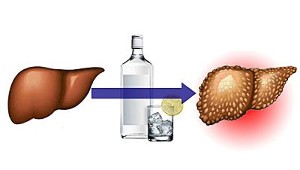The most well-known consequence of alcohol consumption is liver disease. There are many myths about the lesser dangers of consuming vodka, beer, or wine. All alcoholic drinks contain ethanol, a potentially toxic substance, so there are no small or beneficial doses.
The negative consequences of drinking alcohol, even in small doses, are possible, but over a longer period.
Why is alcohol bad for you?
If alcohol is consumed frequently and in excess, it can not only be addictive, but also be the cause of many organic diseases. Ethanol itself and its constituents that appear in the production of alcoholic beverages can be harmful to health.
The following organs are most commonly affected:
- liver (alcoholic fatty liver disease, hepatitis, hepatic cirrhosis);
- stomach (stomach ulcer, dyspepsia);
- colon (colon cancer);
- pancreas (pancreatitis).
Alcohol is highly toxic and addictive. Therefore, it is so difficult for many to stop drinking immediately and without consequences. The lethal dose of ethanol is approximately 8 g per 1 kg of body weight. Therefore, when drinking beer, vodka or drinks, you need to remember moderation, both in quantity and frequency of consumption. Alcohol is a source of what are called empty calories. Consumption in a large amount leads to the development of excess weight (1 g of ethanol-7 kcal).
Alcoholic beverages contribute to the development of various diseases and exacerbate the symptoms of existing diseases.
Therefore, it is worth drinking in small amounts, you can choose drinks that are potentially less harmful. You should also be wary of certain compounds that make ethanol's toxicity worse. But even if you follow these rules, the negative consequences of alcohol consumption will sooner or later be felt.
What determines the harmfulness of alcohol?
The effect of alcohol on the body depends on various factors. What matters is the type and amount of ethanol consumed, gender, genetic factors, time and route of consumption, type of drugs used and general health. Likewise, the effectiveness of alcoholism treatment depends.
The simultaneous consumption of alcohol and tobacco has an extremely harmful effect on the body.
A strong link between alcohol and development has been proven:
- oral tumors;
- neoplasms of the tonsils;
- throat cancer.

The risk of developing these tumors is increased by 30% in people who drink alcohol. At that point, if alcohol is combined with cigarettes, the risk is tripled. Consuming alcohol and cigarettes at the same time increases the risk of negative effects from alcohol and severe hangovers.
One of the common mistakes in developing a hangover is drinking alcoholic beverages on an empty stomach. This speeds up the absorption of alcohol and also leads to an increase in hangover symptoms the next day.
Various flavors used, for example, to make drinks, as well as the combination of many types of alcoholic drinks, also contribute to the occurrence of a hangover. The smallest hangover occurs after ingesting premium vodkas.
Ethanol poisoning can also occur with alcohol abuse. Its symptoms are:
- nausea and vomiting;
- dizziness;
- diarrhea;
- dehydration.
Safe drinks - what does that mean?
Numerous scientific studies (from different centers around the world) report the beneficial effects of very small amounts of alcohol on the functioning of certain organs.
A small amount of alcohol is between 20 and 40 grams of pure ethyl alcohol. Basically we can say it's:
- a small bottle of beer;
- a glass of wine;
- 40 ml of vodka.
The recommendations should not be taken as an inducement to drink alcoholic beverages, let alone for regular, daily consumption. One should not forget about the negative consequences of consuming alcohol, even in small amounts, which can lead to drug addiction.
Many beer and wine drinkers may find it necessary to study the so-called safe amount of alcohol.
A reasonable daily intake has been approved, which in theory should not have a negative effect on the human body, for women it is 20 g of alcohol per day, which corresponds to a small can of beeror a glass of wine. In turn, in the case of men, 40 g of alcohol per day. These restrictions assume consumption no more than 5 times per week. However, even these amounts can be addictive and cause serious damage to health.
It should be noted that it is easier for a woman to become dependent on alcohol than a man. They also have slower metabolic processes for alcohol withdrawal. A woman's consumption of the same amount of alcohol, its concentration in the blood reaches a higher level than that of a man.
Can alcohol have a positive effect?
It doesn't matter what type of alcohol each person drinks and how much. Whether or not it exceeds the dose recognized as safe, it can still lead to illness and addiction. They say it's never too late to stop drinking, however, the sooner you do, the better. So you can avoid its negative impact on the whole body.
Numerous studies have shown that small amounts of alcohol consumed each day increase the amount of good HDL cholesterol. HDL particles work more positively than bad cholesterol (LDL). This is considered to be the only way to remove cholesterol from the body.
It should be noted here again that the role played by alcohol is an exception and is only used at very low doses. Small amounts of alcohol do not affect total cholesterol. According to research, excessive alcohol consumption leads on the contrary to an increase in the parameters of the amount of cholesterol.
You can often read about the health benefits of drinking wine and beer. In fact, they contain certain substances which can have a positive effect on the body. For example, quercetin and resveratrol, found in red wine, have beneficial effects on the heart and vascular system. These are the so-called antioxidants.
However, other less safe foods are also a source of antioxidants: red grapes, berries, apples, nuts. The negative consequences of alcohol consumption will be much more than good here.
How many calories and what ingredients do alcoholic beverages contain?
Wine contains 8. 5-18% ethanol. The calorie content of wine depends on its type. Sweet wines have the most calories (around 94-104 kcal per 100 g). A minimum of calories is provided by dry wine (65-68 kcal per 100 g). The wine contains in particular:
- flavonoids;
- tannins;
- organic acids;
- calcium;
- potassium;
- phosphorus;
- magnesium;
- hardware;
- vitamins of group B.
Red, dry wine is among the least harmful, low in calories, and contains the most antioxidants. Although the content of many valuable compounds is quite high, wine is an alcoholic beverage containing pure ethanol. This means that negative consequences of drinking alcohol, even in this form, are possible.

The alcohol content of beer is very varied - from 0, 2 to 9-10%. Beer, of course, has about 49 kcal per 100 g, dark beer, in turn, has more calories, because in 100 g about 68 kcal.
Beer contains in particular antioxidants and B vitamins, magnesium, potassium, phosphorus. You can find a lot of information about the beneficial effects of beer on the urinary system. But beer is also a source of ethanol. There is a beneficial effect on the urinary system, but it does not compensate for the loss to the body.
High-quality vodka, liqueurs and cognacs contain the greatest amount of ethyl alcohol - from 15 to 80%. They are also very high in calories, vodka contains around 220 kcal per 100 g.
Regardless of the minimum dose consumed, alcohol always has a devastating effect on the whole body. Don't fall for the false facts about the benefits of alcoholic beverages. Alcohol is definitely a useless substance, and sometimes even dangerous in terms of the functioning of organs and systems. The treatment of alcoholism is a very complex and often lengthy procedure that requires special efforts on the part of the patient, his family and medical personnel. The negative consequences of drinking will be far more serious than the fleeting pleasure of being drunk.
























